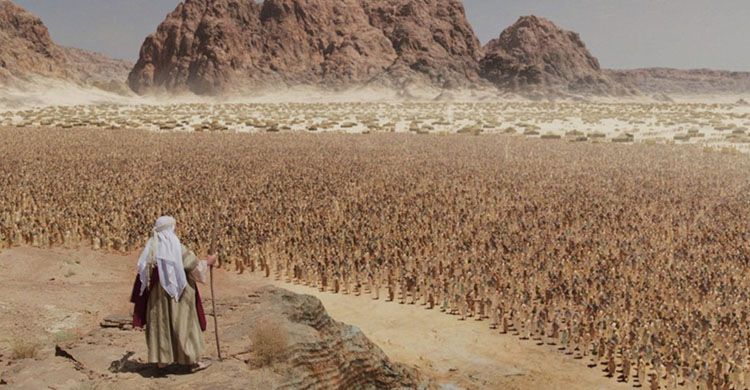Jordan's Long History as a Place of Refuge - Part 2

Moses and the Children of Israel during the Exodus
Forty miles south of Aqaba, in Saudi Arabia, Moses and the children of Israel emerged from the bed of the waters. They crossed on the dry land bridge, now under water and deep enough for freight-laden ships to pass overhead. This is the eastern finger of the Red Sea.
Israel departed from Egypt’s Sinai Peninsula, a place called Nuweiba (new-AY-bah) Beach today. It is near the top of our bucket list to visit. Tall cliffs made it impossible for Israel to escape to the north or south. Pharoah’s army thundered behind them from the west, and waves of the deep Red Sea lapped at their feet on the east.
In this same area of the Red Sea, divers have identified unusual coral encrustations on the ocean floor. They believe these straight-lined, right-angled, circular formations are the remains of Egypt’s chariots. Knowing that coral normally grows in random directions unless attached to something man-made, the divers concluded these objects were Pharaoh’s war machines.
After the miraculous crossing, Israel tracked southward to present-day Jabal al Lawz (ja-BAL al-LAWS) in Saudi Arabia. There, they received the Ten Commandments, built the Tabernacle, and dedicated the priesthood. They then headed northward into what is today Jordan, where they lived under divine protection for the next thirty-eight years.

The biblical names Elath (ay-LAHTH) and Ezion-geber (ATE-tzee-ON GAY-bare) are now known as the cities of Eilat, Israel,and Aqaba, Jordan in the southernmost parts of their respective countries. We find this in Deuteronomy 2:8: “And when we passed by from our brethren the children of Esau, which dwelt in Seir (say-EAR), through the way of the plain from Elath, and from Eziongaber, we turned and passed by the way of the wilderness of Moab.”
When you go to this area today, you will walk where two to three million Israelites trekked with Moses, Aaron, and Miriam.
Miriam
Since there is much controversy about where the locations of Kadesh (KAH-desh) and Kadesh Barnea (KAH-desh bar-NAY-ah) are, it is not yet possible to pinpoint where Miriam was laid to rest in an unmarked grave. Numbers 20:1 simply says, “Then came the children of Israel, even the whole congregation, into the desert of Zin (TZEEN) in the first month: and the people abode in Kadesh; and Miriam died there, and was buried there. (Numbers 20:1)
Aaron
Aaron’s tomb is at the top of Mount Hor in the Kingdom of Jordan. It is the highest peak in the region and lies near Little Petra, which we visited in 2018. Our time constraints did not allow us to drive to Jabal Harun (ja-BAL ha-RUN), Aaron’s Mountain, as it is known in Arabic. However, here is a photo we took of the mountain in the far distance.

Visitors can see the white-domed mosque built in the fourth century that sits on the top of the peak. Both Josephus and Eusebius describe this mountain as above the city of Petra.
David
Before David became king, he hid from Saul in the cave of Adullam (ah-dool-AM). When his brothers and parents learned of it, they fled to him. David took his father and mother to Moab and asked the king to let them stay with him under his protection. He agreed, as we see in 1 Samuel 22:3-4: “David went thence to Mizpah of Moab: and he said unto the king of Moab,‘Let my father and my mother, I pray thee, come forth, and be with you, till I know what God will do for me.’ And he brought them before the king of Moab: and they dwelt with him all the while that David was in the hold.”
David Again
Years later, after David became king, another life-threatening incident arose. His son Absalom (ab-sha-LOM) almost overthrew the kingdom. David sheltered himself and his defenders in Mahanaim (ma-ha-na-IM). “Then David came to Mahanaim. And Absalom passed over Jordan, he and all the men of Israel with him.” (2 Samuel 17:24) This is the same place where Jacob wrestled with a “Man” and received his name change to Israel and where God protected him from his brother Esau.
Outside the city where he fled for safety, David’s and Absalom’s forces met on the battlefield, where the king’s troops killed his wayward son and defeated his men. Although threatened with death, David found refuge in Jordan and secured his throne.
A Remnant of Judah

A remnant of Judeans escaped to Edom, Moab, and Ammon (today’s kingdom of Jordan) during the Babylonian siege of Jerusalem (ca 589-587 BC). After taking the city and removing many of the inhabitants, the king of Babylon commissioned Gedaliah (geh-dal-YAH) as governor of the cities of Judah. When the Judeans heard it was safe to return to their homes, they went back, chose a place to live, and stored food.
Likewise, when all the Jews that were in Moab, and among the Ammonites, and in Edom, and that were in all the countries, heard that the king of Babylon had left a remnant of Judah, and that he had set over them Gedaliah the son of Ahikam (ah-khi-KAM) the son of Shaphan (sha-FAHN); even all the Jews returned out of all places whither they were driven, and came to the land of Judah, to Gedaliah, unto Mizpah, and gathered wine and summer fruits very much. (Jeremiah 40:11-12)
John the Baptist
The forerunner of Yeshua began his ministry on the other side of the Jordan River, as we read in John 1:28. “These things were done in Bethabara (bait-ah-ba-RAH) beyond Jordan, where John was baptizing.” And in John 3:25-26, “Then there arose a question between some of John's disciples and the Jews about purifying. And they came unto John, and said unto him, ‘Rabbi, he that was with thee beyond Jordan, to whom thou barest witness, behold, the same baptizeth, and all men come to him.’ "

“Bethabara (house of the ford) is a place beyond Jordan, in which, according to the Received Text of the New Testament, John was baptizing. If this reading be correct, Bethabara is identical with Beth-barah (fords of Abarah), the ancient ford of Jordan on the road to Gilead; or … the east of the river, nearly opposite Jericho.”[1]Many think it was also known as “Bethany beyond the Jordan,” as we read in John 1:28: “These things (Yeshua’s baptism) took place in Bethany across the Jordan, where John was baptizing.”
“Beyond the Jordan” did not turn out to be a place of refuge for John the Baptist, however. It was there that Herod Antipas (AN-tuh-pus) beheaded him at the Machaerus (mah-KIR-roos) Fortress, a gift from his father and his only palace. It sits atop a high hill east of the Dead Sea in Jordan.
For a closer look at Machaerus, read this article with pictures from documentary film director Tim Mahoney. https://patternsofevidence.com/2021/02/12/herods-dance-floor/

Yeshua
We seldom think of Yeshua’s spending any time in Jordan, but He was there on many occasions, one of which we read in Matthew 19:1-2: “And it came to pass, that when Jesus had finished these sayings, he departed from Galilee, and came into the coasts of Judaea beyond Jordan; and great multitudes followed him; and he healed them there.” He spent time ministering there as well as taking refuge.
Anytime He was in the Decapolis---the ten Roman cities---He was beyond the Jordan (except for one small area near Mount Tabor). The incident in Mark 5 and Matthew 8 of His sending demonic spirits into a 2,000-strong herd of swine took place near one of these cities, Gadara.
“Of the ten cities, Scythopolis, the ancient Bethshean, alone, the capital of the league, was on the West [sic] side of Jordan.[2] Pliny tells us the names of these cities:

Canatha
Damascus
Dion
Gadara
Gerasa
Hippos
Pella
Philadelphia (Amman)
Raphana.
Scythopolis[3]
“The Greek inhabitants were never on good terms with the Jews; and the herd of swine indicates contempt for what was probably regarded as Jewish prejudice.[4] However, Matthew 4:25 tells us, “And there followed him (Yeshua) great multitudes of people from Galilee, and from Decapolis, and from Jerusalem, and from Judaea, and from beyond Jordan.” So, there were more people than the Jews who were interested in this Man whose “name was spread greatly abroad.” (Mark 6:14)
Many miracles Yeshua did were around the Sea of Galilee and in Israel’s countryside. Seldom, if ever, have I thought of His doing anything in what is now Jordan. In last week’s blog, I showed as He was walking in the Jerusalem Temple at Chanukkah in late December, He had an encounter with the religious leaders. They picked up stones to kill Him. He fled back to the place of His baptism, as we see in John 10:39-40. “Again they sought to arrest him, but he escaped from their hands. He went away again across the Jordan to the place where John had been baptizing at first, and there he remained.”
Next time, we’ll write about first-century believers who took seriously Yeshua’s admonition to flee to the mountains when they saw certain signs coming to pass and the future place of refuge during the “Great Tribulation.”
Al and Anita
[1] https://biblebento.com/maps/BL187.html Accessed 07/20/2022
[2]https://bibleatlas.org/decapolis.htm Accessed 08/29/2022
[3]Natural History, v.18
[4]Ibid., https://bibleatlas.org Accessed 08/29/2022
